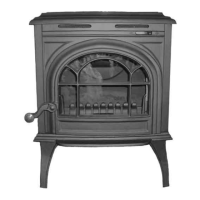Lighting and Operation of Stove
Proper operation of your Hudson stove will help to ensure safe, efcient heating. Please take a few moments to
review these simple operating procedures.
1. Fuel Selection:
The Hudson is designed to burn natural wood only. Higher efciencies and lower emissions generally result when
burning air-dried seasoned hardwoods, as compared to softwoods or to green or freshly cut hardwoods. DO NOT
BURN the following: treated wood, coal, garbage, solvents, colored papers, or trash. Burning these may result in
the release of toxic fumes and may poison or render the catalytics ineffective. Burning coal, cardboard, or loose
paper can produce soot, or large akes of char or y ash that can coat the combustor, causing smoke spillage into
the room, and rendering the combustor ineffective.
2. Building/Maintaining a Fire:
a) Open the primary air slide by pulling it all the way to the right.
b) Place a base of crumpled uncolored newspaper in the bottom of the stove. Lay pieces of kindling on top of
the newspaper and light it.
CAUTION: "Never use gasoline, gasoline-type lantern fuel, kerosene, charcoal lighter uid, or
similar liquids to start or "freshen up" a re in this heater. Keep all such liquids well away from
heater while it is in use.
c) As the kindling begins to burn, add several larger pieces of wood until the re is burning well. At this point,
regular size logs may be added.
NOTE: Until the re is burning well, leave the draft controls fully open.
d) Regulate the heat output of the stove by adjusting the draft controls to allow a larger re and vice versa. A
short period of experimentation with the control settings will allow you to regulate the heat output to keep your
home comfortable.
Do not use a grate or elevate the re. Build wood re on the stove rebox hearth oor.
3. Refueling the Stove:
Use a long pair of gloves (barbecue gloves) when feeding the re because these stoves burn at the front they are
clean and efcient, but they are also very hot and gloves are useful. Keep a small steel shovel and whisk nearby for
moving a log or lifting a fallen ember and for keeping the hearth clean.
a) Before attempting to add fuel to the stove, OPEN the damper control fully by pulling it all the way out. This
allows the chimney to carry away the additional smoke, which occurs when the door is open.
b) DO NOT OVERLOAD THE STOVE. Normally, three or four logs will provide heat for several hours. Never
operate this stove where portions glow red hot.
c) DO NOT OVERFIRE. If the heater or chimney connector glows, you are overring.
d) CAUTION: DO NOT PLACE SUCH FUEL WITHIN SPACE HEATER INSTALLATION CLEARANCES OR WITHIN
THE SPACE REQUIRED FOR CHARGING AND ASH REMOVAL.
4. For Maximum Efciency:
When the stove is hot, load it fully to the top of the door opening, and burn at medium low settings. When the
fuel is mostly consumed, leaving a bed of red coals, repeat the process. Maximum heat for minimum fuel occurs
11

